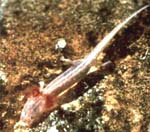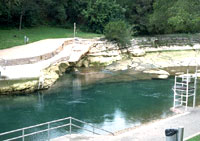At first blush, it hardly seems fair to compare the plight of the Barton Springs salamander to that of endangered species such as the fierce grizzly of the Northern Rockies or the no-longer-so-resilient salmon of the Pacific Northwest, totemic animals that characterize whole regions and spark national debate. After all, the Barton Springs salamander is a tiny creature, with full-grown adults measuring little more than two inches, and the salamander’s range is only a few miles of stream running through the Texas capital of Austin.

Barton Springs salamander:
charismatic microfauna.
Photo: City of Austin.
But given the real and symbolic importance of the springs frequented by the salamander, the deep-in-the-heart-of-Texas struggle to save the salamander has corollaries with the battles on behalf of the nation’s charismatic megafauna. A pair of pending lawsuits filed by Austin environmentalists to protect the Barton Springs salamander belie the notion that bigger creatures inspire — or deserve — bigger support.
One of the suits targets the U.S. EPA for failing to protect water quality along the creek; a legal agreement reached last December continues to languish without an authorizing signature from the Bush administration. The other suit alleges that a new regional water-supply system planned by the semi-private Lower Colorado River Authority fails to adequately address environmental concerns while encouraging unwanted development.
A Deal with the Devil?
Local environmentalists have not always been so aggressive in their litigation. Nearly a decade ago, well ahead of lawsuits that led former Interior Secretary Bruce Babbitt to list the salamander under the Endangered Species Act in 1997, environmentalists brokered a deal intended to prevent developers from impinging on the land around Barton Springs. That deal, spearheaded by the Save Our Springs Alliance (SOS) and known officially as the SOS Ordinance, still stands as a watershed event in Austin politics.

Barton Springs Pool.
Photo: Gregg A. Eckhardt.
The hope was that the ordinance would preserve Barton Springs as a source of drinking water in this notoriously water-deprived state, as (in part) a swimming hole where thousands congregate during the summer to take a break from the hot Texas sun, and — not incidentally — as the home of the Barton Springs salamander. The SOS Ordinance limited building along the Barton Creek section of the Edwards Aquifer “recharge zone,” which feeds Barton Springs and supplies most of Austin’s drinking water.
Viewed by some radical voices as a compromise measure, the ordinance nonetheless mitigated the impact of development in a community largely at the mercy of developers and private-property rights advocates. In turn, zoning rules limited the amount of pollution from runoff and created a boundary of 200 feet around the creek within which development could not take place. Unfortunately for wildlife and swimmers alike, recent tests have shown a variety of pollutants continue to find their way into the spring-fed pools.
The listing of the salamander as a federally protected endangered species in turn gave environmentalists another set of tools to preserve the springs. In fact, the two pending lawsuits filed by SOS advance the cause of U.S. Fish and Wildlife Service scientists entrusted with ensuring the salamanders’ survival. At the heart of both lawsuits is the question of just how development affects the salamander. Says Bill Bunch, chief legal counsel and SOS executive director, “When the salamander was listed, the chief threat was pollution from urban development. The listing definitely helped, but there’s tremendous economic pressure to keep building. It’s not a pretty picture.”
Well-Connected Hicks
Indeed, Census 2000 data indicate that the population of greater Austin has grown more than 26 percent, one of the highest growth rates in the country. (The national growth rate was 9.6 percent. In Boulder County, Colo., which has also seen a tremendous boom in the last 10 years, growth was 21.2 percent.) “We’re fighting a losing battle,” says USFWS biologist Bill Seawell, who believes that a regional watershed protection plan needs to be put in place if Texans are serious about saving the salamander. “Water-quality degradation from development is still the number one threat to the survival of the species.”

Few doubt that the Bush White House will make it even harder to protect endangered species like the salamander, but you don’t have to travel to Washington, D.C., to see the writing on the wall. In Austin, a protracted fight between environmentalists and Stratus Properties reflects one ongoing threat to the salamander. Stratus Properties is seeking approval from the City of Austin for a 4,000-acre development in the Barton Creek watershed that calls for 1,400 homes, a golf course, and more.
The company’s primary investor, Tom Hicks, is well connected. Hicks made news a few years ago when he purchased the Texas Rangers for $250 million from a group of investors that included then-Governor George W. Bush. More recently, Hicks’s firm emerged as one of the top donors to Bush’s presidential campaign.
For many central Texans, the fight to preserve the salamander and its home springs amounts to a battle for the soul of Austin. But optimism is fading. “It all feels kind of fated,” says Robert Bryce, a veteran Austin Chronicle political reporter who has written extensively on Stratus and can be found almost weekly swimming in the Barton Springs pool with his children. “The pool used to be something that symbolized old Austin, but its profile has been eclipsed by the high-tech sector and Bush, so now it symbolizes all that we have lost.”


